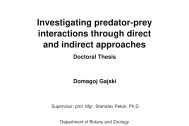Year
2023Content
Having accurate knowledge of trophic interactions in ecosystems is crucial for understanding ecosystem dynamics and the behavior of individual species, and communities within them. Traditional dietary analysis methods, like, for instance, direct observation, have limitations that can prevent us from obtaining a complete picture of trophic interactions occurring within an ecosystem. This is especially the case when working with small and cryptic organisms, such as arthropods and reptiles, where observation of trophic interactions in natural conditions is almost unattainable. This is why scientists focused on obtaining information about such interactions through either an indirect approach by observing density relationships of different organisms in a niche or ecosystem, or through direct approaches, by identifying prey remains in the gut content of predators or by using molecular methods such as PCR detection and dietary metabarcoding.
This Ph.D. thesis comprises four published scientific papers and one accepted one. The aim of this thesis was to investigate predator-prey interactions through various sets of methods that provide either indirect or direct evidence about predator-prey interactions. These approaches were studied on two different types of predators in Southern Moravia (Czech Republic): arthropods in pear orchards and lizards in limestone hills.
The first four manuscripts are focused on arthropods in pear orchards, which were studied for their biological pest control potential by performing a set of methods focused on confirming predation activity, investigating predator-prey density relationships and comparing diet compositions of predators between different seasons and management practices. The last manuscript is focused on the diet of lizards, where we compared the efficacy of macroscopic versus molecular methods for identification of prey remains.
Our results show that modern molecular methods can provide a confident amount of information about predator-prey interactions. However, as with every method, they have their limitations, and are still dependent on the traditional methods to obtain a complete picture of predator-prey interactions. Therefore, only by combining multiple methods together, it allows us to describe complex trophic interactions reliably.



